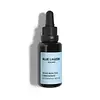What's inside
What's inside
 Key Ingredients
Key Ingredients

 Benefits
Benefits

 Concerns
Concerns

 Ingredients Side-by-side
Ingredients Side-by-side

Caprylic/Capric Triglyceride
MaskingVitis Vinifera Seed Oil
EmollientPrunus Armeniaca Kernel Oil
MaskingOenothera Biennis Oil
EmollientArgania Spinosa Kernel Oil
EmollientCannabis Sativa Seed Oil
EmollientBorago Officinalis Seed Oil
EmollientAscorbic Acid
AntioxidantTocopherol
AntioxidantHelianthus Annuus Seed Oil
EmollientSpirulina Platensis Extract
Skin ProtectingTrehalose
HumectantRosmarinus Officinalis Leaf Extract
AntimicrobialGlycine Soja Oil
EmollientTanacetum Annuum Flower Oil
MaskingCitrus Aurantium Dulcis Peel Oil
MaskingJuniperus Virginiana Oil
MaskingPogostemon Cablin Leaf Oil
MaskingCaprylic/Capric Triglyceride, Vitis Vinifera Seed Oil, Prunus Armeniaca Kernel Oil, Oenothera Biennis Oil, Argania Spinosa Kernel Oil, Cannabis Sativa Seed Oil, Borago Officinalis Seed Oil, Ascorbic Acid, Tocopherol, Helianthus Annuus Seed Oil, Spirulina Platensis Extract, Trehalose, Rosmarinus Officinalis Leaf Extract, Glycine Soja Oil, Tanacetum Annuum Flower Oil, Citrus Aurantium Dulcis Peel Oil, Juniperus Virginiana Oil, Pogostemon Cablin Leaf Oil
Ingredients Explained
These ingredients are found in both products.
Ingredients higher up in an ingredient list are typically present in a larger amount.
You may know this ingredient as argan oil. Argan Oil has antioxidant, hydrating, and soothing properties.
Studies have shown argan oil can help fight again radical damage from the sun. This makes it effective at preventing hyperpigmentation.
Large amounts of vitamin E found in argan oil helps the skin retain water. Argan oil also contains fatty acids such as linoleic acid, oleic acid, and palmitic acid. It is also a good source of lipids.
Another benefit of argan oil is skin-soothing. It can help reduce inflammation-related skin symptoms.
Argan Oil is effective at regulating sebum production in pores. This can make it effective at treating hormonal acne.
Traditionally, argan oil was used for its antibacterial and antifungal properties. However, argan oil contains fatty acids that may make it not fungal-acne safe.
Argan Trees are native to Morocco.
Learn more about Argania Spinosa Kernel OilThis ingredient is an emollient, solvent, and texture enhancer. It is considered a skin-softener by helping the skin prevent moisture loss.
It helps thicken a product's formula and makes it easier to spread by dissolving clumping compounds.
Caprylic Triglyceride is made by combining glycerin with coconut oil, forming a clear liquid.
While there is an assumption Caprylic Triglyceride can clog pores due to it being derived from coconut oil, there is no research supporting this.
Learn more about Caprylic/Capric TriglycerideOenothera Biennis Oil is the fixed oil derived from the seeds of the Evening Primrose.
Evening primrose oil is rich in fatty acids. These fatty acids include linoleic (60-85%), oleic (5-12%), palmitic (4-10%), and stearic (2-4%).
The fatty acid composition makes it a great ingredient for soothing and moisturizing skin. However, it may not be Malassezia folliculitis, or fungal acne safe.
Further research is needed on the role of evening primrose in treating eczema.
Evening primrose is native to North America.
Learn more about Oenothera Biennis OilTocopherol (also known as Vitamin E) is a common antioxidant used to help protect the skin from free-radicals and strengthen the skin barrier. It's also fat soluble - this means our skin is great at absorbing it.
Vitamin E also helps keep your natural skin lipids healthy. Your lipid skin barrier naturally consists of lipids, ceramides, and fatty acids. Vitamin E offers extra protection for your skin’s lipid barrier, keeping your skin healthy and nourished.
Another benefit is a bit of UV protection. Vitamin E helps reduce the damage caused by UVB rays. (It should not replace your sunscreen). Combining it with Vitamin C can decrease sunburned cells and hyperpigmentation after UV exposure.
You might have noticed Vitamin E + C often paired together. This is because it is great at stabilizing Vitamin C. Using the two together helps increase the effectiveness of both ingredients.
There are often claims that Vitamin E can reduce/prevent scarring, but these claims haven't been confirmed by scientific research.
Learn more about Tocopherol